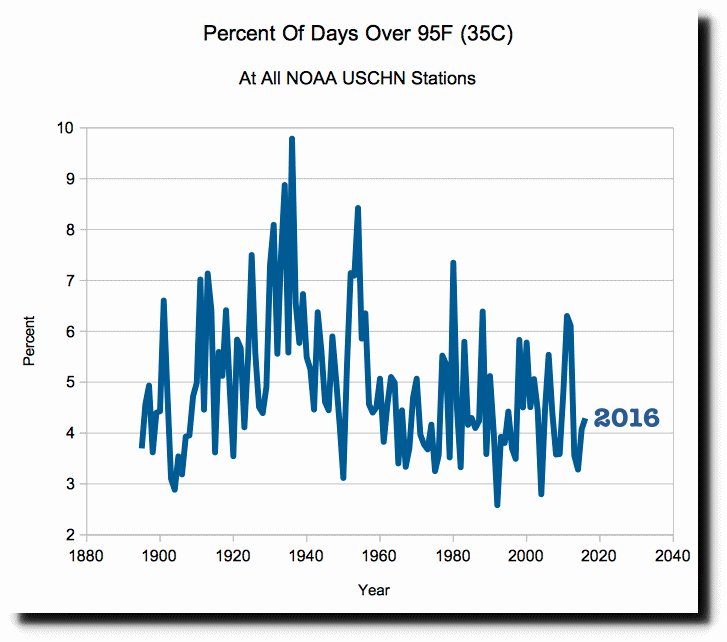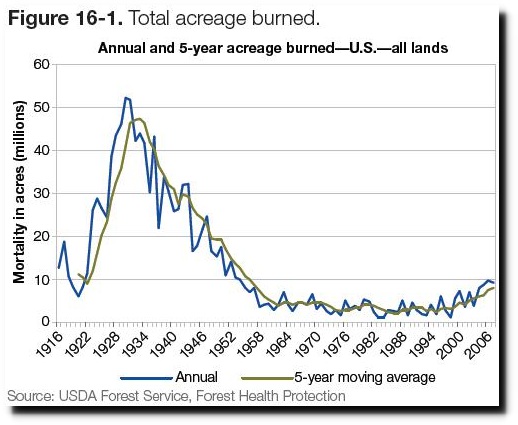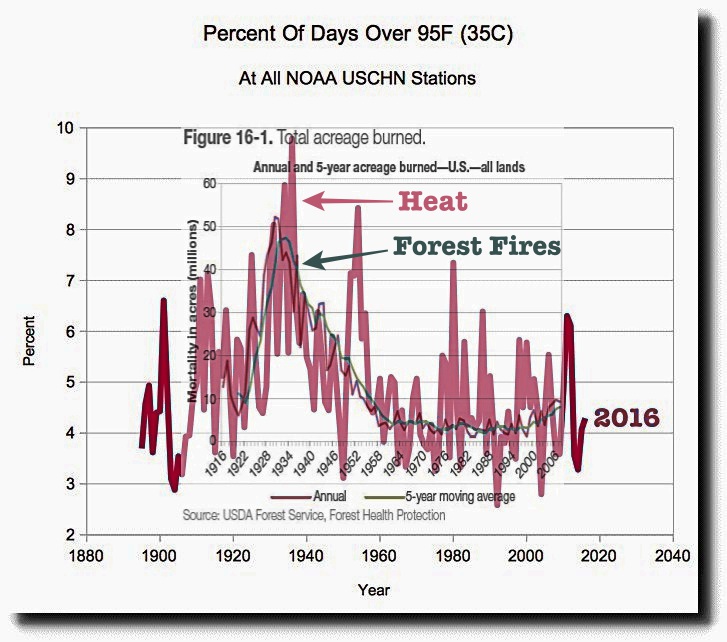Analysis: The 1930’s Was Much Hotter And Drier In The US
The frequency of hot days in the US during the 1930’s was much higher than it is now.
Total burn acreage was also much higher.
Indicator 3.16: Area and percent of forest affected by abiotic agents
The correlation between hot weather and burn acreage is almost perfect.
Government climate experts tell us that the US is getting hotter and fires are increasing.
Wacky Claim: Forests ‘held their breath’ during global warming ‘pause’
From the UNIVERSITY OF EXETER comes this wacky headline:
Forests ‘held their breath’ during global warming hiatus, research shows
Global forest ecosystems, widely considered to act as the lungs of the planet, ‘held their breath’ during the most recent occurrence of a warming hiatus, new research has shown
Global forest ecosystems, widely considered to act as the lungs of the planet, ‘held their breath’ during the most recent occurrence of a warming hiatus, new research has shown.
The international study examined the full extent to which these vital ecosystems performed as a carbon sink from 1998-2012 – the most recent recorded period of global warming slowdown.
The researchers, including Professor Pierre Friedlingstein from the University of Exeter, demonstrated that the global carbon sink — where carbon dioxide is removed from the atmosphere and stored in the natural environment – was particularly robust during this 14 year period.
The study shows that, during extended period of slower warming, worldwide forests ‘breathe in’ carbon dioxide through photosynthesis, but reduced the rate at which they ‘breathe out’ — or release the gas back to the atmosphere.
The team believes the crucial study offers a significant breakthrough for future climate modelling, which is used to predict just how different ecosystems will respond to rising global temperatures.
The pioneering study is published in leading science journal, Nature Climate Change, on Monday, January 23 2017.
MIT climate scientist warns ‘global warming’ fears ‘indoctrinating a generation of young people with foolishness’
WORCESTER – Arctic ice, rising sea levels, and polar bears were the stuff of spirited discussion over bagels and lox Sunday morning at Central Mass. Chabad.
Atmospheric physicist Richard S. Lindzen, the Alfred P. Sloan Professor Emeritus of Meteorology at Massachusetts Institute of Technology and an eminent dissenter from the popular consensus that climate change poses a significant threat to the planet, spoke at a breakfast at the Jewish center at 22 Newton Ave.
Mr. Lindzen’s topic: “Global Warming or Climate Alarmism?” He argued the latter.
While headlines blare “the world is coming to end,” Mr. Lindzen said, that is not happening. A “totally insignificant spike” in temperature of a tenth of a degree last year led to reports that 2016 was the “warmest year on record,” he said. He showed graphs of temperatures over centuries that he said showed fluctuations in temperature are normal.
“The relationship of modest warming to coming catastrophe are blatantly false,” said Mr. Lindzen, who warned against “indoctrinating a generation of young people with foolishness.”
The seas have been rising for 10,000 years, he said. Climate change is cyclical and natural, and the amount of carbon dioxide added to the atmosphere by human activity from the Industrial Revolution to the the present day is arguable, he maintained. Climate “hysteria” is being fed in the cause of a malicious “war on energy” by propagandists of the environmental Left who “want any source of energy as long as it doesn’t work,” he said.
He quoted H.L. Mencken: “The whole aim of practical politics is to keep the populace alarmed and hence clamorous to be led to safety from an endless series of hobgoblins, most of them imaginary.” The time has come to “put the brakes on” climate change alarmism, he said.
…
“So what are they saying this for?” asked Rabbi Fishman. “To scare you!” exclaimed Mr. Lindzen.
…
2016 GLOBAL TEMPERATURE: THE PAUSE NEVER WENT AWAY – ‘HOTTEST’ CLAIMS WITHIN MARGIN OF ERROR
2016 GLOBAL TEMPERATURE: THE PAUSE NEVER WENT AWAY
The Met Office yesterday confirmed that the warm record of 2016 was mainly driven by a very strong El Nino.
Not that you would have heard this fact in the news. But Peter Stott, Acting Director of the Met Office Hadley Centre said in no uncertain terms that, “a particularly strong El Nino event contributed about 0.2°C to the annual average for 2016.”
By removing this temporary El Nino contribution from the Met Office’s 2016 data, it becomes obvious that global average temperatures would be essentially identical to where they were in 2014 (see fig 1). Since the El Nino warming is fading and global temperatures are dropping rapidly, they are close of being back to where they were before the latest El Nino started.
There are two ways to look at the just released global temperature of 2016 and press releases from NASA, NOAA and the Met Office work hard to reflect only one of them.
The emphasis is on long-term warming with the press releases stressing that we are living in the warmest decade of the past 150 years (since instrumental record began) concluding that global warming is continuing unabated. This is one way of seeing the data, but it is not the main lesson which comes out of studying what 2016 adds to the picture of recent warmth.
2016 was clearly among the most warmest of years, but what distinguishes it from the previous years in this century. Everyone agrees it is the strong El Nino. But how strong was its influence?
The NASA GISS dataset has the global temperature of 2016 at 0.99 +/- 0.1°C compared to 0.87 +/- 0.1°C for 2015, a difference of 0.12°C. However, NASA’s Gavin Schmidt said that their estimate of the boost to global temperatures given by the El Nino in 2016 was 0.12°C, that is the difference between 2015 and 2016.
The press release from the Met Office says that 2016 is one of the warmest two years on record and that according to the HadCRUT4 dataset it was 0.77+/- 0.1°C above what it calls the long-term average, which is actually calculated between 1961-1990. 2015 was 0.76+/- 0.1°C making 2016 and 2015 statistically indistinguishable from one another.
However, Peter Stott, Acting Director of the Met Office Hadley Centre said, “A particularly strong El Nino …
MIT climate scientist on ‘hottest year’: ‘The hysteria over this issue is truly bizarre’ – Warns of return ‘back to the dark ages’
Full Audio of Lindzen’s interview.
Dr. Richard Lindzen, the Alfred P. Sloan Professor of Meteorology at MIT and a member of the National Academy of Sciences ridiculed the media hyped claims that 2016 was the “hottest year” on record. Lindzen was on The Howie Carr Show on January 18 to discuss “global warming” and the latest science and the political motivations behind the movement.
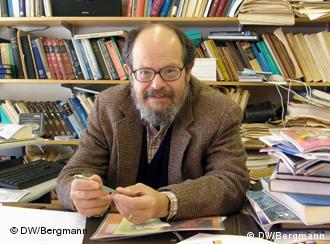
Lindzen on “Hottest Year” claims: (Load of bollocks: 2016 allegedly ‘hottest year’ by immeasurable 1/100 of a degree – While satellites show ‘pause’ continues)
“What happens if your body temp goes up a tenth of a degree, how much do you worry about that? To imply that a rise of temperature of a tenth of a degree is proof that the world is coming to an end — has to take one back to the dark ages.”
“They are talking about temperature data that is rather uncertain. How do you average? You have to make adjustments. That gives them an opening, you can always adjust it up to a quarter of a degree and you will notice that all of the adjustments that are frequently made, always make the temperature seem steeper. They lower the low, they increase the high. In this case (hottest year) they had to depress the high in 1998 to make this one (2016) look a little larger.
But when you are finished you are talking about 2/10ths of degree. No one can feel it. Referring to the New York Times hyping of the “hottest year,” Lindzen added, “Oh boy, can the New York Times can feel it!”
“As long as you can get people excited as to whether it’s a tenth of a degree warmer or cooler, then you don’t have to think, you can assume everyone who is listening to you is an idiot,” he added, noting that “the temperature of the last 20 years is way below what any of the models predicted.”
As to to 2/10ths of degree or a tenth of a degree, nobody can really feel it, not even the New York Times with their immense sensitivity,” Lindzen joked. He also noted that “sea level rise has been going on for 10,000 years, what’s the big deal?”
Adjusting data: “The whole point is so crazy because the temperature is always going up or down a little. What is astonishing is that in the last …
Load of bollocks: 2016 allegedly ‘hottest year’ by unmeasureable 1/100 of a degree – While satellites show ‘pause’ continues
Climate Depot Analysis
It’s that time of year again, the annual media ritual of declaring the previous year “the hottest ever!” And as usual, the media and many activists government scientists are playing fast and loose with the temperature data and.
Former Vice President Al Gore promoted the “hottest year” claim today. “2016 was the hottest year on record — confirmed by NASA and NOAA,” Gore tweeted. (More media hype here: CNN: 2016 was the hottest year on record — again & 2016 breaks record for hottest year ever)

But scientists seemed to yawn at the news.
Extreme Weather expert Dr. Roger Pielke Jr. noted that the media “hottest year” scare stories are simply not working. “Selling climate policy on “hottest year ever” hard because 2016 also had very low disasters & record high crop productivity. It doesn’t scare people,” Pielke wrote.

MIT climate scientist Dr. Richard Lindzen, was very blunt. (See: MIT climate scientist on ‘hottest year’: ‘The hysteria over this issue is truly bizarre’ – Warns of return ‘back to the dark ages’)
Lindzen said in an interview on Howie Carr’s radio show: “To imply that a rise of temperature of a tenth of a degree is proof that the world is coming to an end — has to take one back to the dark ages.” He added, “As long as you can get people excited as to whether it’s a tenth of a degree warmer or cooler, then you don’t have to think, you can assume everyone who is listening to you is an idiot.”
“The whole point is so crazy because the temperature is always going up or down a little. What is astonishing is that in the last 20 years it hasn’t done much of anything,” Lindzen continued.
“What they don’t mention is there has been a big El Nino in 2016 and in recent months the temperature has been dropping back into a zero trend level,” he added.
Load of bollocks: 2016 allegedly the ‘hottest year’ by 1/100 of a degree! UK Met Office: 2016 & 2015 temps the same
…Hottest year claims? Media Ignores The Satellite Record Showing No Warming Since 1998
By Paul Homewood
There must be something wrong with my old eyes, as I can’t seem to find any mention of the satellite record, which shows no such thing.
To recap, both UAH and RSS say that atmospheric temperatures for 2016 statistically tied with 1998, at just 0.02C higher.
Neither 2014 or 2015 were anywhere near being a record.
http://www.nsstc.uah.edu/climate/
Satellite measurements of global temperatures are regarded as much more comprehensive, accurate and unaffected by UHI, as Roy Spencer explained in 2014.
The BBC shows the map provided by NOAA, with lots of red on it to convince us how hot it has been.
However, if they were more honest, they might have showed the Land-Only map, which underlines the fact that most of the world’s land mass has no thermometer coverage at all.
http://www.bbc.co.uk/news/science-environment-38652746
Of course, there might be good reasons why the satellite record has diverged from the surface data in recent years, but is it not the job of the BBC to provide us with all the facts, and not just the ones that suit its political agenda?
…There’s Still Less Warming Than Climate Models Predicted, Despite 2016’s Claimed ‘Record Warmth’
By Michael Bastasch
Right now, the world is about as warm as half the models predicted, but, remember, global surface temperatures were driven up a strong El Nino.
Climate scientist Zeke Hausfather compared the global average temperature record to climate model predictions. 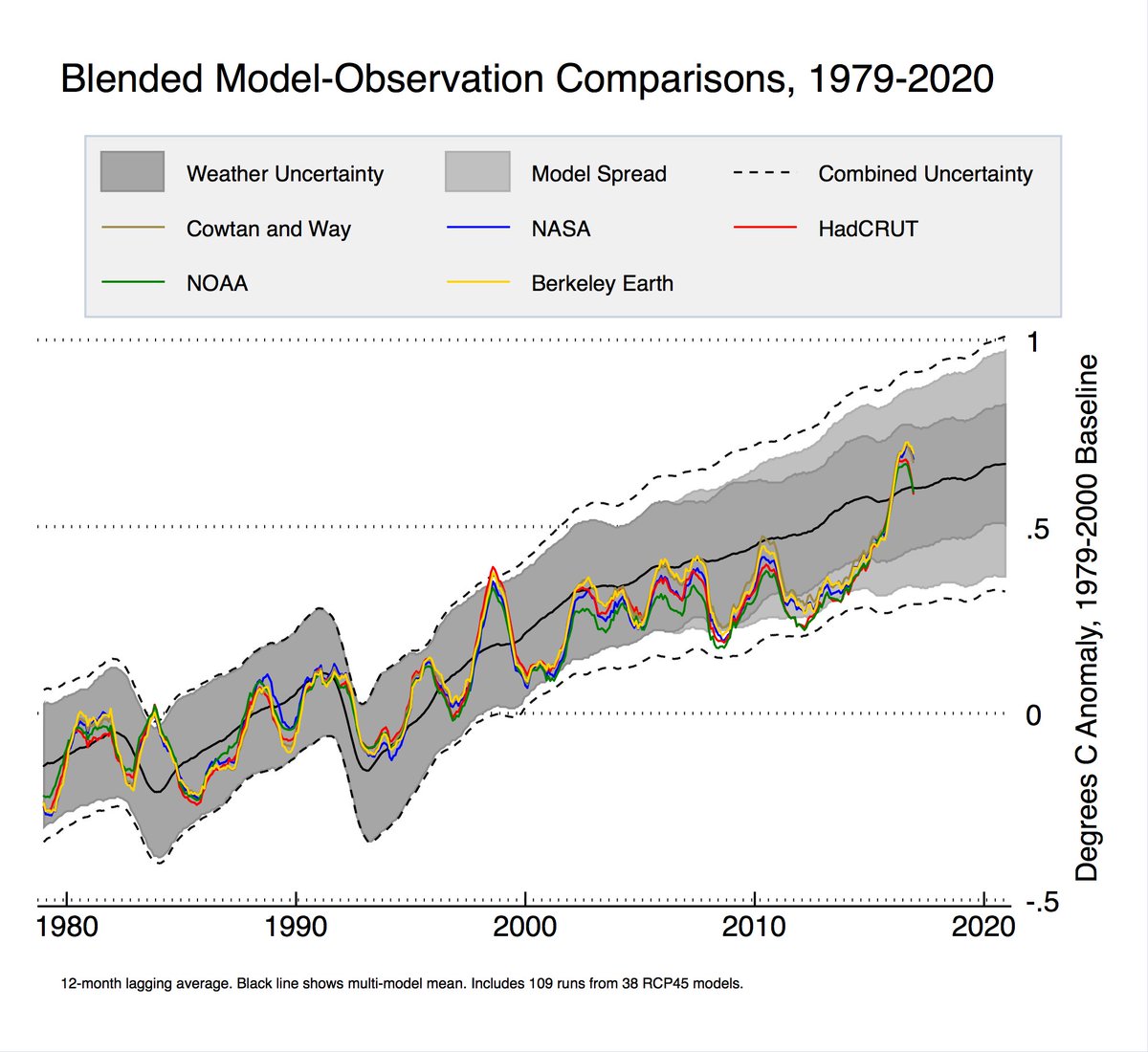
Climate models have consistently over-predicted global warming over longer periods.
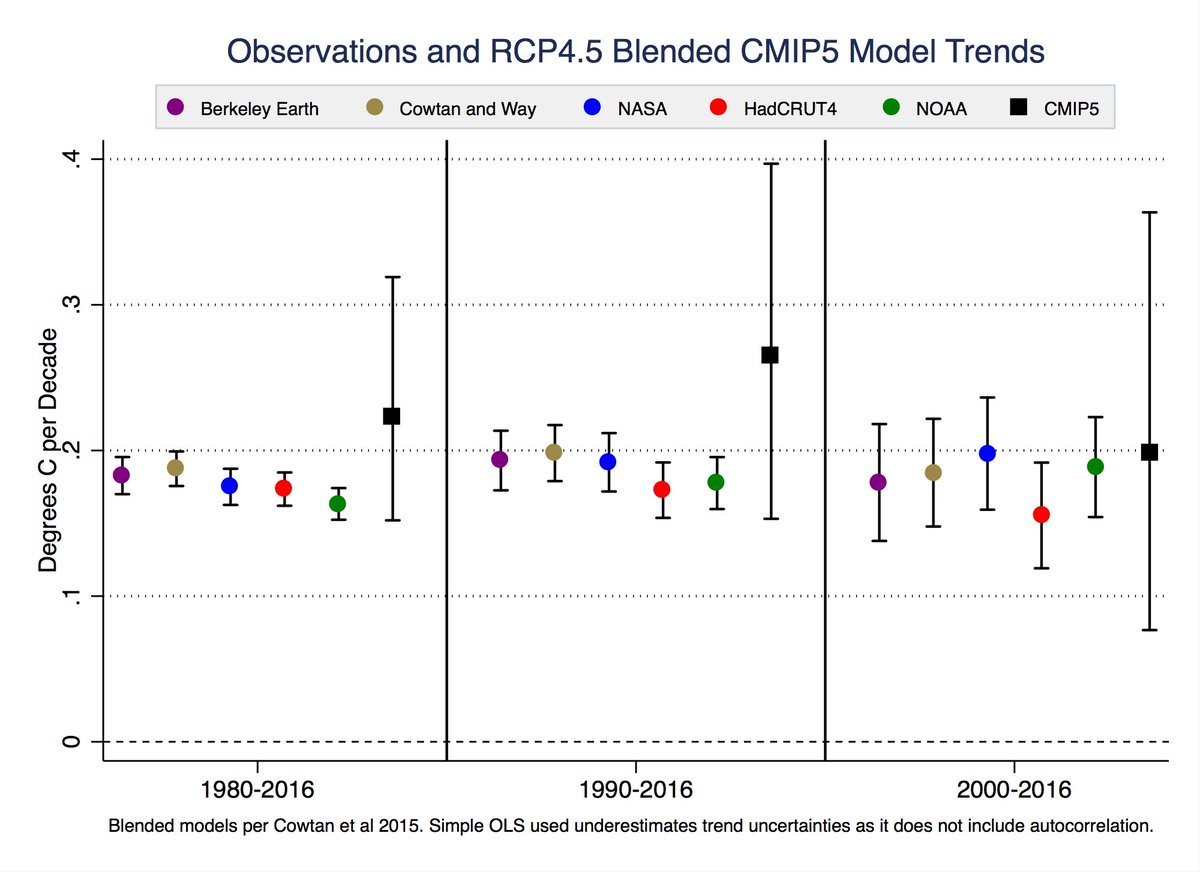
“Bottom line (which remains unchanged by the 2016 global temperatures) … climate models continue to look like they produce too much warming,” Chip Knappenberger, a climate scientist with the libertarian Cato Institute, wrote in an email to The Daily Caller News Foundation.
“It took a near record strong El Nino event (i.e. natural warming event) to do this, and already, as the El Nino Fades the global temperatures are headed back to the lower-half of climate model projections,” he wrote to TheDCNF.…
There is no ‘canonical’ global mean temp: NASA’s temp trends are ‘almost 20 times larger than the satellites’
By Dr. Lubos Motl
Excerpts:
The growing discrepancy between the satellites and the terrestrial measurements could be naively interpreted as bad news for science – there has to be some big mistake at least in one class of these measurements. But this conclusion isn’t really right. Their different stories about the global mean temperature probably aren’t due to a “mistake” but due to their different definition of the global mean temperature. The terrestrially measured temperature is increasing at this rate approximately 2 °C per century while the rate is less than 1.5 °C – and, according some proxies, even much smaller than that – according to the satellites. That’s not a contradiction because they mean different quantities by the “global mean temperature”.
There is no “canonical” global mean temperature. It’s an artificial quantity whose detailed value – and whose detailed change in 18 or 100 years – significantly depends on all the details about how the global mean temperature is defined and measured. I’ve mentioned that 2016 was 0.02 °C warmer than 1998 by satellites but by 0.36 °C warmer than 1998 according to the terrestrial measurements. You may pretty much say that the difference of the annual global mean temperatures in 2016 and 1998 was 0.19 °C plus minus 0.17 °C. It’s still pretty much compatible with the zero at the one-sigma level.
…
The GISS temperature anomaly for 2016 was 0.99 °C, about 0.13 °C warmer than the anomaly in 2015. It’s a significant increase but the increase between 1997 and 1998 was larger still, 0.15 °C. According to GISS, the temperature in 2016 was 0.36 °C warmer than in 1998. You may see that the ratio is almost exactly 0.02 °C per year or 2 °C per century. This deduced trend is almost 20 times larger than that from the satellites but even if we trusted the linear extrapolation, it would still be far from a tragedy if the temperature in 2116 were 2 °C warmer than in 2016.…

